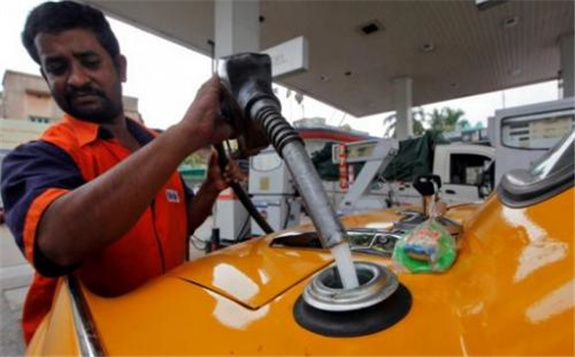Global oil prices have crashed to historic low levels and further disruptions are in store for the global oil markets beginning April when major oil producing countries plan to aggressively increase production, K Ravichandran, Senior Vice-President and Group Head, Corporate Ratings at ICRA told ETEnergyWorld in an interview. Ravichandran explained what low oil prices would mean for the Indian economy and the country’s oil and gas players. Edited Excerpts...

On a macro level how will low oil prices benefit the Indian economy?
Ans. There will be positive as well as negative impacts. On the positive side, our trade balance will improve, as we are big importers of oil. Any reduction in oil prices will help the current account deficit. If you see the latest figures the current account balance has come down to 0.2 per cent of the GDP from a peak of 2.5 per cent recorded during the financial crisis. Any improvement in that is a big positive for the economy in terms of our Dollar holdings.
The second benefit would be reduction in consumer price. When oil prices go down product prices also go down, except when variations in product cracks impact prices. Therefore, reduction in product prices will result in increase in disposable income in the hands of the consumer. Part of the reduction can be absorbed by the government through additional taxes, which the government has done recently by increasing excise by Rs 3 per litre. Different states can also increase VAT going forward, both the centre and the states can participate in the upside from low oil prices.
Assuming all other things remain constant any reduction in oil prices will result in lower inflation both Wholesale and Consumer side. This would have a positive impact on the interest rate and overall economy gets benefitted due to the stimulus provided through lower interest rates.
However, this is happening at a time when the Rupee is depreciating. In the normal course when oil prices go down Rupee should appreciate, but this time Rupee is also depreciating because of the global turmoil. Coronavirus impact and foreign investors pulling out money from the equity and debt markets are having an impact on the exchange rates. But currency should stabilise in some time once the impact of the Coronavirus subsides.
Also, the entire value chain in sectors like airlines, shipping, paint, tyres and petrochemicals gets benefited through lower oil prices and petroleum derivatives. To that extent it would have a second round of impact on the customers and industries like dyes and pigments, pharmaceutical intermediates, agrochemicals and a lot of other products will get cheaper which will be beneficial for the economy.
What would be the impact of this turmoil on India E&P players?
The biggest impact will be on exploration companies. Their business model will undergo a rapid shift. At the current $30 prices not many companies will be profitable. The reason is that cost structure does not go down immediately. Cost structure can decline through lower drilling cost and reduction in other oil field service costs, which takes place over a period of time, maybe after a couple of quarters when oil companies will renegotiate their rates. At this point of time costs will remain rigid and fiscal levies will also remain more or less constant. So, unless they are brought down net cash accruals will take a big hit. Most companies will record losses leave alone cash accruals. So, E&P companies will most likely go slow on their capital expenditure and defer their capex plans which is bad for the capital goods companies, drilling companies and their outlook will also be impacted. In general, E&P companies are big spenders so that impacts EPC companies too.
What will be the impact of such low oil prices on Indian refiners?
There may be an immediate negative impact on inventory losses but once that impact passes subsequent quarters should improve because the interest cost on capital borrowings of refiners will go down. Secondly, internal fuel costs will also go down. So, net impact will be positive next quarter onwards, assuming their cracks remain stable. However, we are also looking at a situation where the overall demand of petroleum products is going down due to the restrictions on public movement due to the Coronavirus outbreak. Considering that product cracks may also be impacted the net impact on the refining sector will be uncertain. At best the impact will be neutral and not a big positive.
The marketing segment should do reasonably okay as pressure on under-recoveries and subsidies will be lower and they can hope to maintain their marketing margins.
How do global oil prices look in 2020?
As of now, prices have tumbled based on the announcement and cut in official selling prices by Saudi Arabia. Actual increase in production will happen only from April onwards. Currently, Saudi Arabia produces close to 10 million barrels per day and they are projected to produce around 12.5 mbd in April, which is a very big jump. Russia may also increase its production. So, the real impact will be in the month of April. If they mean what they say then prices could even touch $20-25 levels but prices cannot sustain at this level. No country and no company can sustain at this level.
Of course, Saudi Arabia can sustain at low oil price levels, but low oil prices have a wider macro-economic implication for Saudi Arabia. Even at $5-10 its not as if Saudi Arabia will make losses. They will certainly be profitable because their cost structure is one of the lowest in the world, but that is not sufficient for the economy. For the country’s budget to break-even they would require oil prices at $70-$80 per barrel. The government relies on oil revenue to spend on infrastructure and on social sectors. So, Saudi Arabia cannot sustain at these low oil price levels and so is the case with other countries.
Russia is today putting up a brave front saying that it can sustain at $30-40 for few more years. However, that may not be true. There are issues brewing. People and the industry will be fed up will low prices and austerity measures. So, low oil prices will not go down well with Russia, too. Other Middle East countries like Kuwait, Iran, Iraq which also rely heavily on oil revenues will take a hit. At some point of time all of these countries will have to decide upon curtailing production.
For the US as most of the shale companies are small and independent, as per their business model they need to keep investing in drilling wells. Only then they will be able to sustain production levels. So, their free cash flows are always negative and they will have to fund operations through bank borrowings or through bond route. During low oil prices, bankers and the bond market would not oblige them. So they would find difficult to sustain production levels. Many of the companies do hedging. Even when oil prices are at $25-30 per barrel they would have the benefit of hedge for one or two more quarters after which their production will start falling.
Re-balancing has to happen, US production has to go down and OPEC+ will have to curtail production. By that time hopefully the Coronavirus impact will also subside and demand would pick up. All of this will take at least 3-4 quarters to come to normalcy. In the meantime, prices can go down to $20 also. However, such prices cannot sustain for long as it has grave implications on the financial markets. It could be short-lived with one quarter experiencing a severe impact and gradually it would lead towards normalcy. It should take 2-4 quarters. Eventually I see oil prices at $50-60 per barrel.
What would be a comfortable oil price band for Indian E&P players?
It would be different for different companies. Largely we are talking about government National Oil Companies and private E&P players. All of them are relatively smaller in the E&P space. NOCs with diversified portfolio will be less impacted. While other E&P companies which solely rely on crude oil sales will have more exposure to oil price crash. The cost structure of some private E&P players is very efficient. Even at $7-10 they would be able to break-even. However, the issue is that you have to also generate enough profits to replace your reserves. In that regard they would require a minimum of $40-45 per barrel to achieve meaningful profits.
In the case of NOCs with overseas oil and gas assets their cost structure is somewhat adverse to oil prices as these assets are present in countries where fiscal levies are fairly large and big part of the revenue is eaten up by fiscal levies and sharing of revenue. NOCs with overseas assets as well as a diversified portfolio would require more than $50 per barrel for decent profits.
How have Asian product cracks been lately ?
Product cracks have been subdued due to demand. The demand for aviation fuel has slumped, so is the case with other transportation fuels. To that extent petrol, diesel cracks have been low. Shipping market is also going through turmoil as global trade movement is getting impacted. Product cracks will continue to remain under pressure. I do not see any improvement for at least a quarter.
Natural gas prices will be revised next month. What can the industry expect?
Currently it is at $3.2 per mmbtu and prices should drop to $2.7-2.8 per mmbtu because prices have crashed in the global markets. If you go by the formula, whether it is US, China, UK or Russia, prices of natural gas have been under pressure in these countries and that will reflect in India’s pricing as well, which will be negative for E&P sector. It will be one of the lowest recorded natural gas prices since the formula has been in place.







